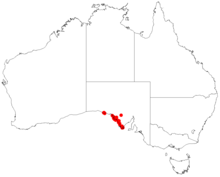| West coast mintbush | |
|---|---|

| |
| In Maranoa Gardens | |
| Conservation status | |
 Vulnerable (EPBC Act) | |
| Scientific classification | |
| Kingdom: | Plantae |
| Clade: | Tracheophytes |
| Clade: | Angiosperms |
| Clade: | Eudicots |
| Clade: | Asterids |
| Order: | Lamiales |
| Family: | Lamiaceae |
| Genus: | Prostanthera |
| Species: | P. calycina |
| Binomial name | |
| Prostanthera calycina F.Muell. ex Benth. | |

| |
| Occurrence data from AVH | |
| Synonyms | |
| |
Prostanthera calycina, the West Coast mintbush, limestone mintbush or red mintbush, is a species of flowering plant that is endemic to the Eyre Peninsula in South Australia. It is a small, more or less prostrate shrub with aromatic, elliptic to oblong leaves and red flowers.
Description
Prostanthera calycina is a more or less prostrate shrub that typically grows to a height of about 0.5 m (1 ft 8 in) and has more or less cylindrical, hairy branches. The leaves are well-spaced along the branchlets, elliptic to oblong, 4–14 mm (0.16–0.55 in) long and 3–5 mm (0.12–0.20 in) wide on a densely hairy petiole 0.8–1.4 mm (0.031–0.055 in) long. The leaves are strongly aromatic when crushed. The flowers are arranged singly in leaf axils on a hairy pedicel 2.5–4.5 mm (0.098–0.177 in) long. The sepals are 8–14 mm (0.31–0.55 in) long forming a tube 6–8 mm (0.24–0.31 in) long with two lobes 4–6 mm (0.16–0.24 in) long and 5–7 mm (0.20–0.28 in) wide. The petals are 17.5–22 mm (0.69–0.87 in) long forming a tube 13–15 mm (0.51–0.59 in) long with two lips. The middle lobe on the lower lip is about 4 mm (0.16 in) long and 3 mm (0.12 in) wide, the side lobes about 3 mm (0.12 in) long. The upper lip has two lobes about 5 mm (0.20 in) long and joined but with a small notch between them. Flowering occurs between September and December.
Taxonomy
Prostanthera calycina was first formally described in 1870 by George Bentham from an unpublished description by Ferdinand von Mueller and the description was published in Flora Australiensis.
Distribution and habitat
West coast mintbush is only known from the Eyre Peninsula in South Australia where it usually grows on limestone outcrops in mallee vegetation.
Conservation status
West coast mintbush is classified as "vulnerable" under the Australian Government Environment Protection and Biodiversity Conservation Act 1999 and the South Australian Government National Parks and Wildlife Act 1972. The main threats to the species include grazing, habitat fragmentation and road maintenance.
Use in horticulture
This mintbush is easily propagated from cuttings or by grafting onto Prostanthera nivea and grows best in dry climates in well drained soil.
References
- ^ "Prostanthera calycina". Australian Plant Census. Retrieved 22 August 2020.
- "SPRAT Profile: Prostanthera calycina — West Coast Mintbush, Limestone Mintbush, Red Mintbush". Australian Government Department of Agriculture, Water and the Environment. Retrieved 22 August 2020.
- "Prostanthera calycina". State Herbarium of South Australia. Retrieved 22 August 2020.
- Conn, Barry John (1984). "A taxonomic revision of Prostanthera Labill. Section Klanderia (F.v.Muell.) Benth. (Labiatae)" (PDF). Journal of the Adelaide Botanic Gardens. 6 (3): 303–305. Retrieved 22 August 2020.
- ^ "Approved Conservation Advice for Prostanthera calycina (West Coast Mintbush)" (PDF). Australian Government Department of the Environment. Retrieved 22 August 2020.
- "Prostanthera calycina". Australian Plant Name Index. Retrieved 22 August 2020.
- Bentham, George; von Mueller, Ferdinand (1870). Flora Australiensis. pp. 107–108. Retrieved 22 August 2020.
- "Prostanthera calycina". Australian Native Plants Society (Australia). Retrieved 22 August 2020.